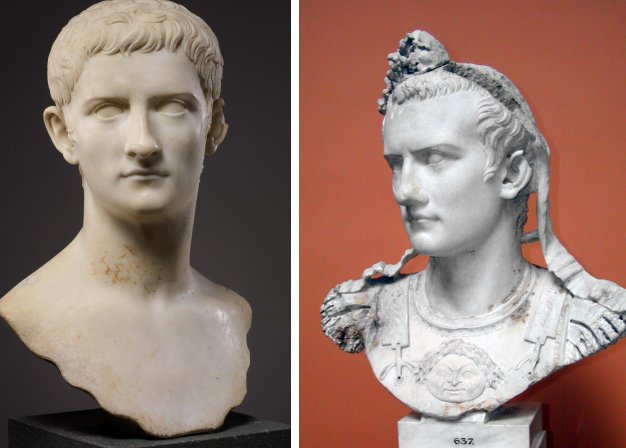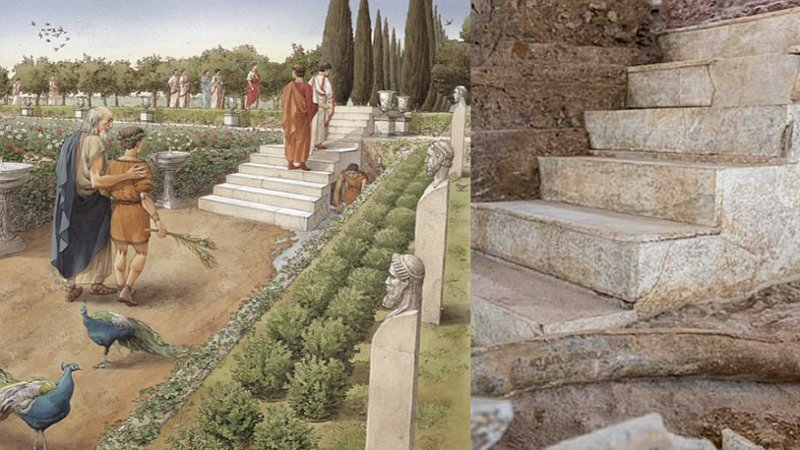Jan Bartek – MessageToEagle.com – Archaeologists have found the remains of Emperor Caligula’s luxury home and exotic garden.
Stabbed to death by the Praetorian Guard in A.D. 41 Caligula is today remembered as one of the most horrible Roman emperors of all time.
Many ancient Romans were happy when he was gone, and he was considered a tyrant who ultimately became a monster.

Bust of Caligula. Credit: Left: Metropolitan Museum of Art – Right: – CC BY-SA 3.0
“Remember that I have the right to do anything to anybody,” Caligula once said, and he lived by his words torturing and executing people whenever he wished.
His extravagant lifestyle cost taxpayers a fortune. He built a magnificent palace where he drank pearls dissolved in vinegar and ate food covered in gold leaf. On top of everything he also forced people to worship him as a god.
After three years digging under the offices of Enpam, a doctors’ pension institute along Piazza Vittorio Emanuele II, a piazza in south-eastern central Rome scientists have now found remains of Caligula’s lavish home. What stands out most is his exotic garden where he kept wild animals.
Scientists “found a luxury palace with an ornate garden complete with water fountains and an exotic menagerie that housed ostriches, deer, and even a bear.
Fragments of pottery and frescoes from Caligula’s home and garden. Credit: Soprintendenza Speciale di Roma
Artifacts taken from the site, including jewels, coins, animal bones, and a metal brooch belonging to an imperial guard, are set to go on public display,” Daily Mail reports.
“The remains tell incredible stories, starting from the animals,” Dr. Mirella Serlorenzi at the Ministry of Cultural Heritage and Activities told the Times.
“We have found bones from the foot of a lion, the tooth of a bear, and bones of ostriches and deer. We can imagine animals running free in this enchanted landscape, but also wild animals that were used for the private circus games of the emperor.”
Artist’s impression of the garden would have looked, full of free-roaming wildlife and engraved water features.
Caligula who ruled Rome from A.D. 37 to 41 was according to many historians a perverted man, who sought pleasure in many ways. He committed incest with his sisters, told his wife to go around naked in front of guests and forced men and women of high rank to have sex with him.
The Roman garden culture was significantly developed after 60 BC. Roman gardens were influenced by Egyptian, Persian, and Greek gardening techniques Roman gardens were beautiful but not as unusual as the one Caligula ordered to create.
A water pipe with the name of Claudius, which means that not only Caligula but also his successor was linked with the building.
That he kept exotic animals in his garden isn’t very surprising. He wanted to experience the best of everything, and scientists also unearthed seeds of imported exotic plants, as well as remains of a white marble staircase that linked different levels of the garden.
The remains of a white marble staircase that linked different levels of the lavish garden.
Was Caligula insane? It’s a question several historians have tried to answer. If Caligula was mad, why wasn’t he silently removed from public view and placed under the care of a physician? Was it easier to get rid of this emperor simply by murdering him?
Caligula’s history is interesting because there are few surviving sources about his reign and some stories about the emperor can be misinformation.
But there is no doubt he was a very hated man. Aloys Winterling writes in his book Caligula that “to some extent modern scholarship has gone too far in transforming a ruler depicted as immoral and insane into a good one whose actions were rational.
Both modern and ancient interpretations have concluded from this alleged evidence that Caligula was insane. But was he?
This biography tells a different story of the well-known emperor. In a deft account written for a general audience, Aloys Winterling opens a new perspective on the man and his times. Basing Caligula on a thorough new assessment of the ancient sources, he sets the emperor’s story into the context of the political system and the changing relations between the senate and the emperor during Caligula’s time and finds a new rationality explaining his notorious brutality. Read more
Above all, however, one question remains open: How can one explain the intense hatred for Caligula that is expressed in ancient accounts of him?
Almost all the sources can be traced back to members of the Roman aristocracy. They stem from senators and knights who were in direct contact with the emperor.
Caligula’s magnificent sapphire ring is 2,000-year-old. Credit: Wartski
Thus even their false statements about Caligula contain a degree of historical truth: The Roman aristocracy must have experienced such appalling things under his rule that posthumously he was tarred with the worst possible stigma: He was reviled as a monster and a madman and thus expelled outright from human society.”
Caligula’s madness can be debated, but the remains of his home and garden clearly show he was a very extravagant man, and so does his astonishing 2,000-year-old sapphire ring that caused a sensation when it was made available for purchase on an auction by Royal jewelers Wartski.
Written by Jan Bartek – MessageToEagle.com – AncientPages.com Staff Writer







